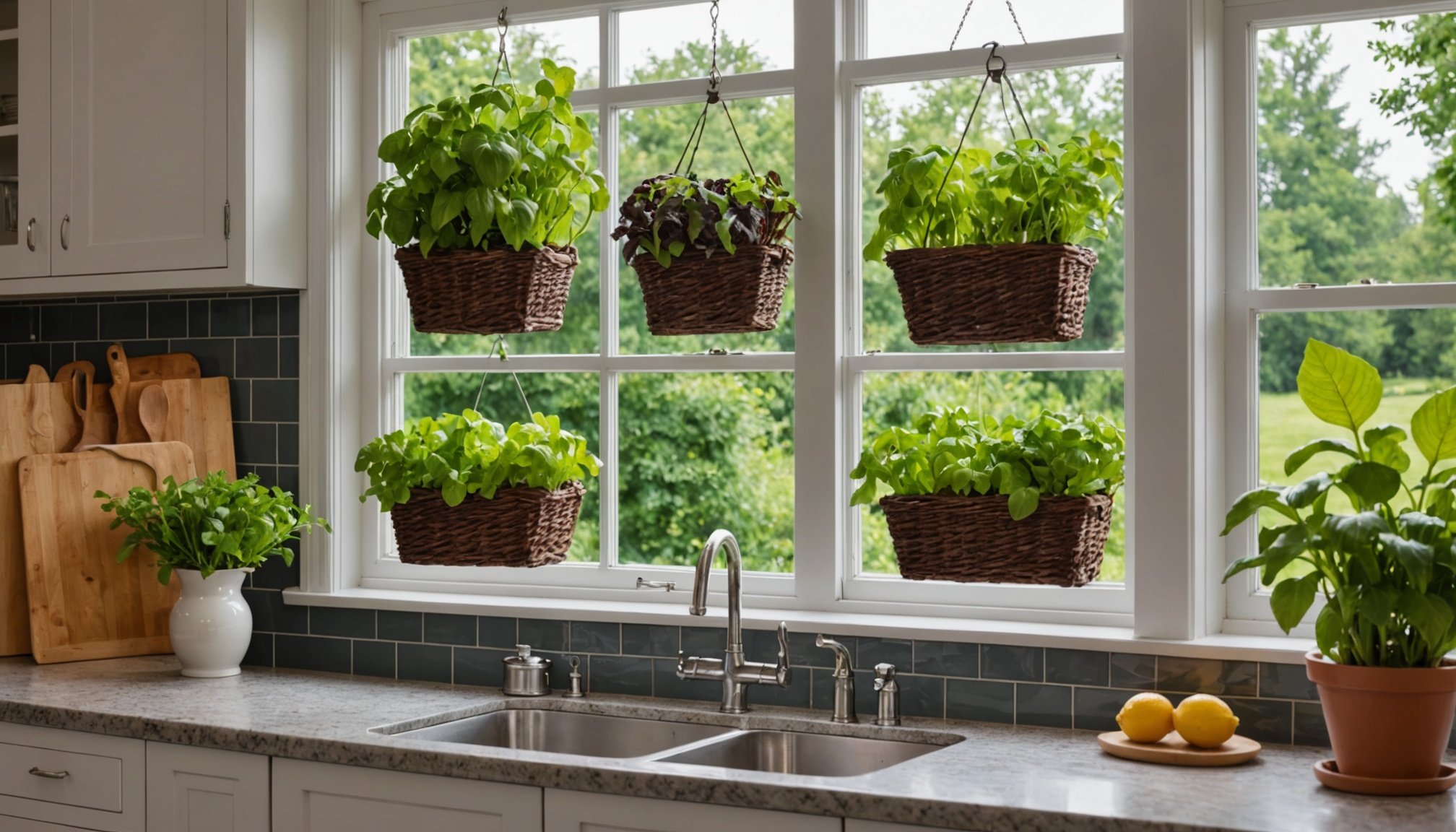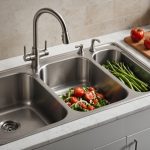Transform Your Home Cooking: Discover the Advantages of a Kitchen Garden Window for Culinary Inspiration
Why a Kitchen Garden Window is a Game-Changer
Imagine stepping into your kitchen, surrounded by the fresh aroma of herbs and the vibrant colors of growing plants. A kitchen garden window is more than just a decorative element; it’s a functional and inspiring addition to your home that can elevate your cooking and dining experience. Here’s why incorporating a kitchen garden window into your kitchen design can be a transformative decision.
Enhancing Your Kitchen Design
A kitchen garden window is not just about aesthetics; it’s a thoughtful design element that can significantly enhance the functionality and ambiance of your kitchen. These windows, often larger and more expansive than traditional windows, allow ample natural light to flood your kitchen, creating a brighter and more inviting space.
Additional reading : Finding the Perfect Spot: Tips for Placing a Wine Cooler in Your Cozy Kitchen
"Natural light is essential for any kitchen. It not only makes the space feel more welcoming but also helps in highlighting the colors and textures of your ingredients, making cooking a more enjoyable experience," says a home design expert.
When planning your kitchen design, consider how a garden window can become a focal point. It can be a beautiful way to bring the outdoors in, creating a seamless transition between your indoor and outdoor spaces. For example, if you have a small herb garden outside, a garden window can provide a continuous view of your plants, making it easier to harvest fresh herbs right from your kitchen.
The Benefits of Growing Your Own Herbs
One of the most significant advantages of a kitchen garden window is the opportunity to grow your own herbs year-round. Here are some compelling reasons to start your own herb garden:
In the same genre : Discover the Top Thermal Insulation Materials for Kitchen Floors in the UK”s Colder Climates
Freshness and Flavor
Growing your own herbs ensures that you have the freshest ingredients at your fingertips. There’s nothing quite like the flavor and aroma of herbs that have been harvested just moments before use.
"Using fresh herbs from my kitchen garden window has completely changed the way I cook. The flavors are more vibrant, and the dishes feel more alive," says a home cook.
Health and Nutrition
Home-grown herbs are free from pesticides and other chemicals often found in store-bought produce. This makes them a healthier choice for your family.
Convenience
Imagine being able to snip off a few sprigs of rosemary or thyme without having to leave your kitchen. This convenience can inspire more creative and spontaneous cooking.
Cost-Effective
Growing your own herbs can save you money in the long run. No more frequent trips to the grocery store for expensive bunches of herbs.
Choosing the Right Herbs for Your Kitchen Garden
Not all herbs are created equal when it comes to growing in a kitchen garden window. Here are some popular and easy-to-grow herbs that thrive in indoor conditions:
- Basil: A classic choice for any kitchen garden, basil is easy to grow and adds a fresh, bright flavor to many dishes.
- Mint: While mint can be invasive, it grows well in containers and can be harvested continuously. It’s perfect for teas, salads, and desserts.
- Cilantro: This fast-growing herb does well in cooler temperatures and can be harvested in as little as three weeks.
- Parsley: A slow-growing herb that prefers partial shade, parsley is a great addition to any kitchen garden.
- Thyme: Thyme is a low-maintenance herb that can thrive in indoor conditions with minimal care.
How to Set Up Your Kitchen Garden Window
Setting up a kitchen garden window is easier than you might think. Here are some steps and tips to get you started:
Selecting the Right Window
When choosing a garden window, consider the amount of natural light your kitchen receives. A south-facing window is ideal for most herbs, but if your kitchen receives less light, you may need to supplement with LED grow lights.
| Feature | Description |
|---|---|
| Natural Light | Ensure the window receives sufficient natural light for plant growth. |
| Ventilation | Look for windows with built-in ventilation to maintain air circulation. |
| Space | Choose a window with enough space to accommodate multiple plants. |
| Ease of Access | Opt for a window that allows easy access for watering and harvesting. |
| Energy Efficiency | Select energy-efficient windows to keep your kitchen warm in winter and cool in summer. |
Preparing the Soil and Containers
Use well-draining soil and containers that fit snugly into the window box. Here are some tips for preparing your soil and containers:
- Soil: Use a high-quality potting soil that is specifically designed for indoor plants.
- Containers: Choose containers that have good drainage holes to prevent waterlogged soil.
- Fertilization: Use organic fertilizers to promote healthy plant growth.
Maintaining Your Herb Garden
Maintaining your kitchen garden window is relatively straightforward. Here are some key tips:
- Watering: Water your herbs when the top inch of soil feels dry to the touch.
- Pruning: Regular pruning encourages bushy growth and prevents the plants from becoming leggy.
- Pest Control: Keep an eye out for pests like aphids and spider mites, and use organic pest control methods whenever possible.
Integrating Your Kitchen Garden into Your Cooking Routine
Once your kitchen garden window is set up, it’s time to integrate it into your cooking routine. Here are some ideas to get you started:
Daily Harvesting
Make it a habit to harvest a few herbs each day. This will encourage you to use them more frequently in your cooking.
Meal Planning
Plan your meals around the herbs you have available. For example, if you have a lot of basil, consider making pesto or caprese salads.
Experimenting with New Recipes
Having fresh herbs at your disposal can inspire you to try new recipes. Experiment with different combinations of herbs to find new flavors you love.
The Environmental Benefits of a Kitchen Garden Window
In addition to the culinary benefits, a kitchen garden window also offers several environmental advantages:
Energy Efficiency
By growing your own herbs indoors, you reduce the need for transportation and packaging associated with store-bought herbs. This can lead to a more energy-efficient and sustainable lifestyle.
Reduced Carbon Footprint
Growing your own food reduces your reliance on industrial agriculture, which can have a significant carbon footprint. Here are some ways a kitchen garden window can help:
- Less Transportation: No need for herbs to be transported from farms to stores.
- No Packaging: Eliminate the plastic and paper packaging used for store-bought herbs.
- Local Production: Produce your own herbs locally, reducing the demand for imported produce.
Creating a Harmonious Kitchen Space
A kitchen garden window is not just about functionality; it’s also about creating a harmonious and inviting kitchen space. Here are some tips to ensure your kitchen garden window blends seamlessly with your kitchen design:
Open Plan Kitchens
If you have an open plan kitchen, a garden window can help create a sense of continuity between the kitchen and dining areas.
Window Design
Choose a window design that complements your kitchen style. For example, a modern kitchen might benefit from a sleek, minimalist garden window, while a traditional kitchen might look better with a more ornate design.
Lighting
Ensure that the lighting in your kitchen complements the natural light from the garden window. This can create a warm and welcoming atmosphere perfect for cooking and dining.
A kitchen garden window is more than just a decorative element; it’s a transformative addition to your home that can enhance your cooking, improve your health, and contribute to a more sustainable lifestyle. Whether you’re a seasoned gardener or a culinary novice, the benefits of a kitchen garden window are undeniable. So why not take the leap and create your own kitchen garden window? Your taste buds, your health, and the environment will thank you.
Practical Tips and Ideas
Here are some additional tips and ideas to help you make the most of your kitchen garden window:
Window Box Ideas
- Use a window box that is at least 6-8 inches deep to provide enough root space for your herbs.
- Add a trellis or other support for climbing herbs like mint or lemongrass.
- Incorporate a self-watering system to reduce maintenance.
Herb Pairing Ideas
- Basil and Tomatoes: Plant basil near tomatoes to improve their flavor and repel pests.
- Mint and Lemon: Pair mint with lemon balm for a refreshing and citrusy flavor combination.
- Thyme and Rosemary: Grow thyme and rosemary together for a classic Mediterranean flavor profile.
Seasonal Planting
- Spring: Plant cool-season herbs like cilantro, parsley, and dill.
- Summer: Focus on warm-season herbs like basil, mint, and lemongrass.
- Fall: Transition to cool-season herbs again, adding some kale and spinach for a winter harvest.
- Winter: Use LED grow lights to continue growing herbs like thyme, rosemary, and sage.
By following these tips and ideas, you can create a thriving kitchen garden window that not only enhances your cooking but also adds a touch of natural beauty to your home.











